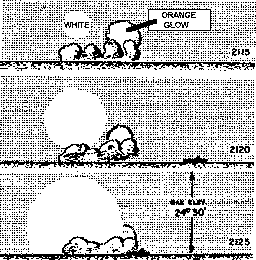 |
Science Frontiers ONLINE No. 61: Jan-Feb 1989 |
|
|
Expanding ball of light (ebl) phenomenon
 X8. June 22, 1976. North Atlantic. "At 2113 GMT a pale orange glow was seen to be coming from behind a bank of towering cumulus to the west. At 2115 a ghostly white disc (see sketches) was observed at an approximate altitude of 10-degrees and bearing 290-degrees. The glow from behind the cloud persisted." The glowing region developed as indicated in the figure. Stars could be seen throught the disc at all times. By 2140 the disc had disappeared. |
"According to several pilot witnesses, the center of the EBL is at relatively high altitude while it is forming. Its color is evenly whitish or yellowish and becomes increasingly transparent to background stars as it expands. As it enlarges it appears to maintain a sharply defined edge. At some point it fades completely from sight. The rate of boundary interface expansion is impossible to determine without knowing its distance from the observer. It is also of interest to note that most EBL events have taken place after dark. If EBL phenomena are associated with an advanced weapons test, one wonders why it would be conducted (a) after dark, and (b) in so many different geographic areas."
(Haines, Richard F.; "Expanding Ball of Light (EBL) Phenomenon," Journal of Scientific Exploration, 2:83, 1988.)
Comment. In our Catalog volume Lightning, Auroras, Nocturnal Lights, we describe many phenomena of the EBL type under GLA15. For a description of this volume, visit: here.